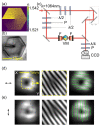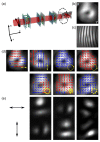A Gaussian to Vector Vortex Beam Generator with a Programmable State of Polarization
- PMID: 36363385
- PMCID: PMC9654547
- DOI: 10.3390/ma15217794
A Gaussian to Vector Vortex Beam Generator with a Programmable State of Polarization
Abstract
We study an optical device designed for converting the polarized Gaussian beam into an optical vortex of tunable polarization. The proposed device comprised a set of three specially prepared nematic liquid crystal cells and a nano-spherical phase plate fabricated from two types of glass nanotubes. This device generates a high-quality optical vortex possessing one of the multiple polarization states from the uniformly polarized input Gaussian beam. Its small size, simplicity of operation, and electrical steering can be easily integrated into the laboratory and industrial systems, making it a promising alternative to passive vortex retarders and spatial light modulators.
Keywords: beam polarization conversion; optical vortices; structured light polarization.
Conflict of interest statement
The authors declare no conflict of interest.
Figures





References
-
- Rubinsztein-Dunlop H., Forbes A., Berry M.V., Dennis M.R., Andrews D.L., Mansuripur M., Denz C., Alpmann C., Banzer P., Bauer T., et al. Roadmap on Structured Light. J. Opt. 2017;19:013001. doi: 10.1088/2040-8978/19/1/013001. - DOI
-
- Yao A.M., Padgett M.J. Orbital Angular Momentum: Origins, Behavior and Applications. Adv. Opt. Photon. AOP. 2011;3:161–204. doi: 10.1364/AOP.3.000161. - DOI
-
- Soskin M., Vasnetsov M. Chapter 4—Singular Optics. Prog. Opt. 2001;42:219–276. doi: 10.1016/S0079-6638(01)80018-4. - DOI
-
- Zhan Q. Cylindrical Vector Beams: From Mathematical Concepts to Applications. Adv. Opt. Photon. AOP. 2009;1:1–57. doi: 10.1364/AOP.1.000001. - DOI
-
- Brown T.G. Progress in Optics. Volume 56. Elsevier; Amsterdam, The Netherlands: 2011. Unconventional polarization states: Beam propagation, focusing, and imaging; pp. 81–129. - DOI
Grants and funding
LinkOut - more resources
Full Text Sources

